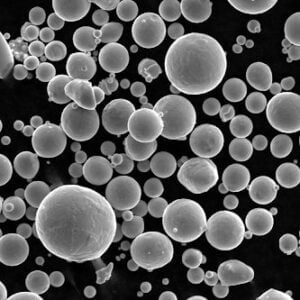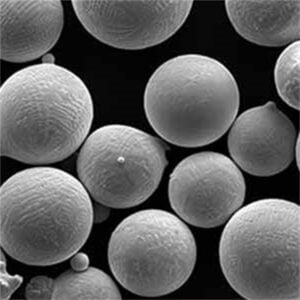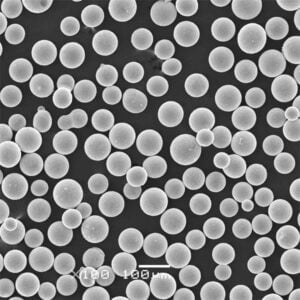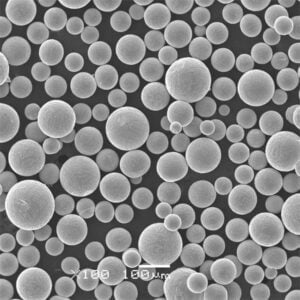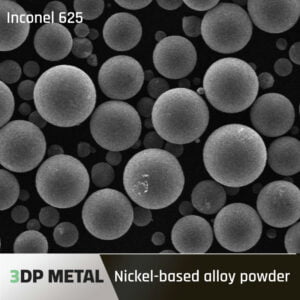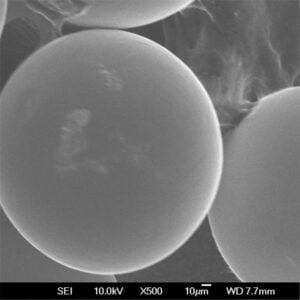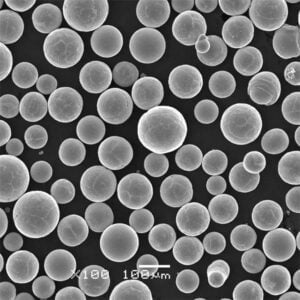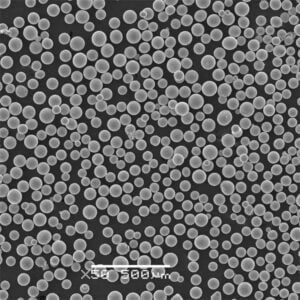Volframpulver med hög densitet
Innehållsförteckning
Volframpulver med hög densitet har den största densiteten bland alla metallpulver på grund av volframs utomordentligt höga inre densitet som närmar sig guldets. Detta unika attribut möjliggör avancerad design av kompakta, vikteffektiva komponenter inom olika sektorer genom att utnyttja tunga pulverpressnings- och sintringsmetoder.
Översikt av volframpulver
Med en densitet på 19,3 g/cm3 i fast form, packar volfram enorm vikt i en liten volym. På grund av detta ger volframpulver när det är kompakterat oöverträffade densitetsnivåer som inte kan uppnås med något annat material. Delar tillverkade av volframpulver med hög densitet har många användningsområden i krävande miljöer.
Viktiga drivkrafter för att använda volframpulver med hög densitet inkluderar:
- Hög densitet som liknar ädelmetaller som guld, platina
- Fördubblar den tillgängliga densiteten jämfört med bly, stål
- Möjliggör tunga men ändå kompakta storlekar och former
- Enkel pulvermetallurgisk väg till slutanvändningsartiklar
- Skräddarsydda egenskaper genom att blanda legeringselement
- Återvinningsbarhet av högvärdigt volfram
Tillämpningar som drar nytta av densitetsspannas ballaster, strålningsblockering, tröghet, viktning av kompositer, vibrationsdämpning och komponentminiatyrisering.
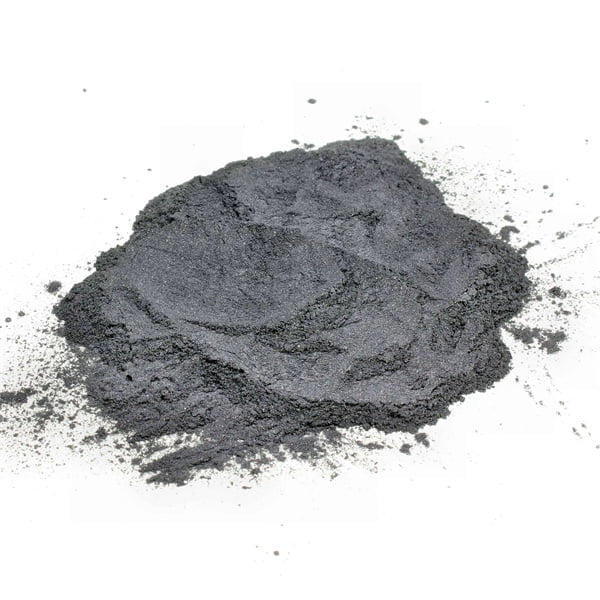
Typer av volframpulver med hög densitet
Medan alla volframpulvervarianter erbjuder hög densitet, ger vissa kvaliteter och kompositioner optimala densitetsnivåer efter formning och sintring:
| Typ | Beskrivning | Typisk densitet |
|---|---|---|
| Ren volfram | Högre renhet över 99.95% säkerställer pålitlig densitet | ≥18 g/cm |
| Dopat volfram | Små sällsynta jordartsmetaller som Y2O3 förbättrar sintrade densitet | ≥18,5 g/cm |
| Volfram-nickel-järn | Ni-Fe-legering ger utmärkt slutdensitet | ≥18 g/cm |
| Tunglegeringar av volfram | 90-97% W med Ni-Cu-Fe bindemedelsfaser | ≥17,5 g/cm |
| Volframkompositer | Blandar med guld, tantal, utarmat uran mm. | upp till 21 g/cm |
Dessa förbättrade formuleringar utökar högpresterande alternativ bortom ren volfram till skräddarsydda egenskapskombinationer.
Sammansättning av volframpulver
Högrent volframpulver lämpligt för högsta möjliga densitet innehåller över 99.95% volfram med endast mindre kvarvarande föroreningar:
| Element | Maximalt innehåll | Roll |
|---|---|---|
| Volfram (W) | 99.95% | Huvudkomponent |
| Kol (C) | 100 ppm | Korntillväxthämmare |
| Syre (O) | 100 ppm | Oxid på ytan |
| Koppar (Cu) | 10 ppm | Kvarvarande spår förorening |
| Kiseldioxid (Si) | 20 ppm | Orenhet |
Specialiserade tunga legeringar har avsiktliga legeringstillsatser som nickel, koppar, järn etc. tillsammans med volfram för att förbättra egenskaperna ytterligare.
Fastigheter av volframpulver
Volframpulver med hög densitet möjliggör tillverkning av delar i nästan nätform med extrem densitet i kombination med användbar styrka, hårdhet och termiska egenskaper.
Fysikaliska egenskaper
| Fastighet | Värde |
|---|---|
| Täthet | ≥18 g/cm 3 |
| Smältpunkt | 3380-3410°C |
| Styrka | Upp till 1000 MPa |
| Hårdhet | ≥400 VPN |
| Termisk ledningsförmåga | ~175 W/(m·K) |
| Koefficient för termisk expansion | ~4,5 μm/(m·K) |
Dessa egenskaper härrör från volframs inneboende atomstruktur och gör den idealisk för applikationer med hög densitet som kräver termisk-mekanisk integritet.
Mekaniska egenskaper
Noggrann pulverpressning och sintring ger fördelaktiga mekaniska egenskaper:
| Fastighet | Värde |
|---|---|
| Hårdhet | Upp till 550 VPN |
| Utbyteshållfasthet | ~900 MPa |
| Draghållfasthet | Upp till 1000 MPa |
| Töjning | ~10% till 15% |
| Brottseghet | ∼20 MPa√m |
| Utmattningshållfasthet | 500 MPa |
Legeringselement som nickel, järn etc. hjälper till att skräddarsy duktilitet, seghet och bearbetningsegenskaper.
Fysiska attribut
Framträdande fysiska egenskaper hos volframpulver med hög densitet som är användbara för designers:
| Parameter | Värde | Enhet |
|---|---|---|
| Täthet | 18 till 19.3 | g/cm 3 |
| Elektrisk resistivitet | 5.5 | μΩ·cm |
| Termisk konduktivitet | 170 | W/(m·K) |
| Smältpunkt | 3410 | °C |
| Kokpunkt | 5930 | °C |
| Specifik värme | 132 | J/(kg·K) |
Den ultrahöga smältpunkten och värmeledningsförmågan säkerställer bibehållande av styrka och dimensionell integritet vid extrema temperaturer.
Produktion av volframpulver
| Etapp | Beskrivning | Nyckelpunkter |
|---|---|---|
| 1. Råvaruanskaffning | Processen börjar med att bryta volframmalm, som i första hand består av wolframit och scheelite. | * Volframmalmer finns över hela världen, men stora producenter inkluderar Kina, Peru och Bolivia. * Gruvmetoder varierar beroende på fyndigheten, men vanliga tekniker inkluderar dagbrott och underjordsbrytning. * Den utvunna malmen genomgår krossnings-, malnings- och koncentreringsprocesser för att avlägsna föroreningar och berika volframhalten. |
| 2. Kemisk bearbetning | Den koncentrerade malmen omvandlas sedan till en mellanliggande kemisk förening lämplig för ytterligare rening och reduktion. | * Ammoniumparawolframat (APT) är den mest använda mellanprodukten. Det produceras genom en rad kemiska reaktioner som involverar urlakning, filtrering och utfällning. * APT erbjuder fördelar som hög renhet och goda hanteringsegenskaper. * Andra mellanliggande föreningar som volframsyra eller volframoxider kan också användas beroende på den specifika tillverkningsprocessen. |
| 3. Oxidproduktion med hög renhet | Ytterligare reningssteg säkerställer avlägsnande av kvarvarande föroreningar och uppnår den önskade nivån av volframoxid för reduktion. | * APT genomgår ytterligare reningssteg som omkristallisation eller lösningsmedelsextraktion för att uppfylla de stränga renhetskraven för produktion av volframpulver. * Volframoxider som WO3 (volframtrioxid) eller WO2 (volframdioxid) är ofta slutprodukten av detta steg. * Valet av oxid och dess specifika egenskaper kan påverka de slutliga volframpulveregenskaperna. |
| 4. Vätgasreduktion | Den renade volframoxiden reduceras sedan till metalliskt volframpulver med hjälp av vätgas i en kontrollerad ugnsmiljö. | * Detta stadium är hjärtat i produktionen av volframpulver. Väte fungerar som ett reduktionsmedel, tar bort syre från volframoxiden och lämnar efter sig rena volframmetallpartiklar. * Reduktionsprocessen sker i skjutugnar eller roterande ugnar vid exakt kontrollerade temperaturer (vanligtvis mellan 600°C och 1100°C) och vätgasflödeshastigheter. * Noggrann kontroll av dessa parametrar är avgörande för att uppnå önskade volframpulveregenskaper som partikelstorlek, morfologi och renhet. |
| 5. Pulverklassificering och efterbehandling | Det råa volframpulvret från reduktionsugnen genomgår ytterligare bearbetning för att uppnå de slutliga önskade egenskaperna. | * Pulvret siktas och klassificeras för att erhålla specifika partikelstorleksfördelningar. Olika tillämpningar kräver pulver med olika partikelstorlekar och morfologier. * Ytterligare processer som målning eller granulering kan användas för att förfina partikelstorleken och formen ytterligare. * Pulvret kan också utsättas för avgasningsbehandlingar för att avlägsna eventuellt kvarvarande väte från reduktionsprocessen. |
| 6. Kvalitetskontroll | Under hela produktionsprocessen genomförs rigorösa kvalitetskontrollåtgärder för att säkerställa att det slutliga volframpulvret uppfyller alla nödvändiga specifikationer. | * Kemisk analys bestämmer pulvrets elementära sammansättning och renhet. * Partikelstorleksfördelning och morfologi analyseras med hjälp av tekniker som laserdiffraktion och elektronmikroskopi. * Andra tester kan bedöma egenskaper som densitet, flytbarhet och sintringsbeteende. * Att bibehålla jämn kvalitet är avgörande för prestanda för volframprodukter gjorda av pulvret. |
Tillämpningar av volframpulver
| Kategori | Tillämpning | Fastigheter med hävstångseffekt | Exempel |
|---|---|---|---|
| Industri & Tillverkning | Bearbetnings- och skärverktyg | Extrem hårdhet, slitstyrka | – Borr – Fräsar – Pinnfräsar – Svarvverktyg |
| Dies & formar | Hög smältpunkt, termisk stabilitet | – Extruderingsformar för trådar och filament – Varmpressningsverktyg – Plastformsprutningsverktyg | |
| Elektroder | Hög smältpunkt, bra elektrisk ledningsförmåga | – Inertgassvetselektroder (TIG) – Motståndssvetselektroder | |
| Filament & värmeelement | Hög smältpunkt, bra elektrisk ledningsförmåga | – Glödlampsglödtrådar – Ugnsvärmeelement | |
| Katalysatorer | Hög yta, förmåga att främja kemiska reaktioner | – Ammoniakproduktionskatalysatorer – Kolvätebearbetningskatalysatorer | |
| Pigment & Beläggningar | Hög densitet, opacitet för röntgenstrålar | – Strålningsskärmning för medicinsk utrustning – Röntgenkontrastmedel | |
| Elektricitet och elektronik | Elektriska kontakter och brytare | Hög smältpunkt, bra elektrisk ledningsförmåga, ljusbågsmotstånd | – Reläkontakter – Effektbrytare – Högspänningsställverkskontakter |
| Kylflänsar | Hög värmeledningsförmåga | – Elektronisk komponent värmeavledning | |
| Halvledartillverkning | Hög densitet, etsningsmotstånd | – Volframpluggar och vias i integrerade kretsar – Gateelektroder i transistorer | |
| Konsumentvaror | Sportartiklar (Golfklubbor, fiskevikter) | Hög densitet för viktfördelning | – Golfklubbviktning för förbättrad sving – Fiskevikter för djupare, snabbare sjunkande |
| Vibrationsdämpning | Hög densitet | – Dämpare i tennisracketar och bågskytteutrustning – Vibrationsdämpare i maskiner | |
| Avancerade applikationer | Additiv tillverkning (3D-utskrift) | Fin partikelstorlek, bra flytbarhet | – 3D-printade komponenter för flyg- och bilindustrin – Medicinska implantat |
| Kärnenergi | Hög smältpunkt, neutronabsorption | – Styrstavar i kärnreaktorer – Kärnavfallsskärmning | |
| Militär & försvar | Pansarpiercing penetratorer | Hög densitet, extrem hårdhet |
Specifikationer
Nyckelparametrar definierade för volframpulver med hög densitet:
Kvaliteter av Tungsten Powder
| Betygsbeteckning | Genomsnittlig partikelstorlek (mikron) | Renhet (minst % Tungsten) | Tillämpningar |
|---|---|---|---|
| Ultrafint volframpulver | < 1.0 | ≥ 99,95 | – Termisk spraybeläggning för turbinblad och andra applikationer med hög slitage på grund av utmärkt sintringsförmåga och flytbarhet. |
| 1.0 – 3.0 | ≥ 99,95 | – Diamantverktyg med överlägsen slitstyrka och skärpa för skärning och slipning av hårda material. | |
| 3.0 – 5.0 | ≥ 99,9 | – Elektroniska substrat med minimala föroreningar för hög elektrisk ledningsförmåga och termisk stabilitet i integrerade kretsar. | |
| Fint volframpulver | 5.0 – 10.0 | ≥ 99.5 | – Hårdmetallskärverktyg som erbjuder en bra balans mellan hårdhet, seghet och brotthållfasthet för bearbetning av olika material. |
| 10.0 – 15.0 | ≥ 99,0 | – Kraftiga elektriska kontakter som kräver hög smältpunkt, ljusbågsmotstånd och elektrisk ledningsförmåga i strömbrytarapplikationer. | |
| 15.0 – 22.0 | ≥ 98,5 | – Elektroder för Tungsten Inert Gas (TIG)-svetsning på grund av deras förmåga att producera en stabil båge och koncentrerad värme. | |
| Medium volframpulver | 22.0 – 32.0 | ≥ 98,0 | – Penetratorer och kinetiska energiprojektiler som utnyttjar volframs höga densitet för överlägsen pansarpenetrering. |
| 32.0 – 45.0 | ≥ 97,0 | – Strålningsskyddsmaterial i medicinsk utrustning och kärntekniska anläggningar på grund av volframs förmåga att absorbera röntgenstrålar och gammastrålar. | |
| Grovt volframpulver | 45.0 – 75.0 | ≥ 96,0 | – Ballastvikter för motvikter och vibrationsdämpare som använder volframs höga densitet för kompakt storlek och effektivitet. |
| > 75,0 | ≥ 95,0 | – Shot Peening Media för ytförstärkning av metallkomponenter genom en kallbearbetningsprocess. |
Standarder för Tungsten Powder
| Fastighet | Beskrivning | Betydelse | Typiska standarder |
|---|---|---|---|
| Renhet | Volframpulverrenhet hänvisar till viktprocenten volframmetall (W) som finns i pulvret. Föroreningar kan avsevärt påverka de fysiska och mekaniska egenskaperna hos volframprodukter. | Högre renhet leder i allmänhet till bättre prestanda i applikationer som förlitar sig på egenskaper som elektrisk ledningsförmåga, smältpunkt och styrka. Men extremt hög renhet är kanske inte alltid nödvändigt eller kostnadseffektivt. | – Hög renhet (99.9% W och högre): Används för elektronik, filament och elektroder där utmärkt elektrisk ledningsförmåga är avgörande. – Standardrenhet (99.5% W – 99.9% W): Lämplig för olika applikationer som skärverktyg i hårdmetall, kylflänsar och strålningsskärmning. – Lägre renhet (under 99.5% W): Används i vissa specifika applikationer som plastfyllmedel eller som råmaterial för ytterligare rening. |
| Partikelstorlek och distribution | Partikelstorlek avser medeldiametern för enskilda volframpartiklar i pulvret. Partikelstorleksfördelning beskriver variationen i partikelstorlekar inom ett pulverprov. | Partikelstorlek och distribution påverkar avsevärt bearbetningsbeteendet och slutegenskaperna hos volframprodukter. Till exempel kan finare partiklar erbjuda bättre sintringsförmåga men kan vara mer utmanande att hantera. | – Pulver i mikronstorlek (1–50 mikron): Används vanligtvis för tillverkning av hårdmetall, termisk sprutning och additiv tillverkning. – Submikronpulver (under 1 mikron): Används i applikationer som kräver stor ytarea, som katalysatorer och ledande beläggningar. – Nanopulver (under 100 nanometer): Framväxande område med potentiella tillämpningar inom elektronik och kompositmaterial. |
| Skenbar densitet | Skenbar densitet representerar vikten av volframpulver per volymenhet, med tanke på utrymmena mellan partiklarna. Det påverkar hur mycket pulver som kan packas i en form och den sintrade produktens slutliga densitet. | Högre skenbar densitet möjliggör effektivare användning av pulver och kan leda till tätare slutprodukter med förbättrade mekaniska egenskaper. | – Högdensitetspulver (>10 g/cm³): Används för applikationer som kräver hög hållfasthet och slitstyrka, som hårdmetallverktyg. – Standarddensitetspulver (7 – 10 g/cm³): Används vanligtvis för olika applikationer där en balans mellan densitet och lätthet vid bearbetning önskas. – Pulver med låg densitet (<7 g/cm³): Kan användas i applikationer där lös packning eller flytbarhet är viktig, såsom vissa termiska sprutningsprocesser. |
| Flytbarhet | Flytbarhet hänvisar till den lätthet med vilken volframpulver kan röra sig och hällas. Det är avgörande för effektiv hantering och bearbetning i olika applikationer. | God flytbarhet säkerställer smidig pulvermatning i maskiner och minimerar segregering av olika partikelstorlekar i pulvret. | – Friflytande pulver: Uppnås genom specifik partikelstorleksfördelning och ytbehandlingar för att minimera partikel-partikelinteraktioner. – Tillsatser: Kan användas för att förbättra flytbarheten genom att minska friktionen mellan partiklar. |
| Morfologi | Morfologi hänvisar till formen och formen av individuella volframpartiklar. | Partikelmorfologi kan påverka packningsbeteende, sintringsegenskaper och den slutliga mikrostrukturen hos volframprodukter. | – Sfäriska pulver: Erbjuder bra packningstäthet och flytbarhet. – Vinkelpulver: Kan skapa ett mer sammankopplande nätverk under sintring, vilket kan leda till förbättrad styrka. – Dendritiska pulver: Kan användas för specifika applikationer där deras förgreningsstruktur ger fördelar. |
| Syrehalt | Syrehalt hänvisar till mängden syre som finns i volframpulvret, vanligtvis som oxider. För mycket syre kan påverka de slutliga egenskaperna hos volframprodukter. | – Lågt syreinnehåll är i allmänhet önskvärt för de flesta applikationer för att säkerställa optimal prestanda. – Strikta syregränser är ofta specificerade för högpresterande applikationer som elektronik och filament. | |
| Tappdensitet | Tappdensitet är ett mått på packningsdensiteten hos volframpulver som uppnås genom en standardiserad tappningsprocess. Det ger ett indirekt mått på flytbarhet och skenbar densitet. | – Högre krandensitet indikerar bättre packningseffektivitet och kan användas som kvalitetskontrollparameter. | – Industristandarder anger ofta minimikrav för krandensitet för olika volframpulverkvaliteter. |
Prissättning
Representativ prissättning av volframpulver lämpligt för användning med hög densitet:
| Betyg | Pris |
|---|---|
| Ultrafin | $800 till $1200 per kg |
| Submikron | $500 till $900 per kg |
| Fina | $100 till $250 per kg |
| Medium | $50 till $150 per kg |
| Tunga legeringar | $40 till $100 per kg |
Mindre partikelstorlekar, högre renhet, speciella dopmedel och lägre kvantitet ökar kostnaden. Återvunnet skrotpulver är billigare.
För- och nackdelar
| Fördelar | Nackdelar |
|---|---|
| Oöverträffad hög smältpunkt: Volframpulver har den högsta smältpunkten av någon metall och når svindlande 3 422 °C (6 192 °F). Denna exceptionella egenskap gör att den kan utmärka sig i applikationer som utsätts för extrema temperaturer, som ugnsfoder, raketmunstycken och värmesköldar för återinträde av rymdfarkoster. | Dyr investering: Att extrahera och bearbeta volfram är en komplex procedur som leder till en högre prislapp jämfört med vanligare metaller. Detta kan vara ett betydande hinder för applikationer där kostnaden är en viktig faktor. |
| Överlägsen värme- och elektrisk ledningsförmåga: Volframpulver utmärker sig genom att effektivt leda både värme och el. Detta gör den idealisk för applikationer som kräver effektiv värmehantering, som kylflänsar i elektronik, eller elektriska komponenter som glödtrådar i glödlampor och elektroder för svetsning. | Tät och krävande: Volframs anmärkningsvärda densitet, en direkt följd av dess tätt packade atomstruktur, översätts också till dess pulverform. Denna höga densitet kan innebära utmaningar under bearbetningen. Specialiserade tekniker och utrustning kan behövas för att hantera och forma volframpulver effektivt. |
| Exceptionell slitage- och korrosionsbeständighet: Volframpulver uppvisar enastående motståndskraft mot slitage, tillsammans med exceptionell korrosionsbeständighet. Detta gör den perfekt för applikationer som kräver exceptionell hållbarhet i tuffa miljöer, som pansargenomträngande projektiler, borrkronor för tuffa material och komponenter som används i kemiska bearbetningsanläggningar. | Potentiella hälsorisker: Volframpulver, om det andas in, kan irritera lungorna och potentiellt leda till hälsokomplikationer. Strikta säkerhetsprotokoll och korrekt ventilation är avgörande när man arbetar med volframpulver för att minimera exponeringsriskerna. |
| Skräddarsydd legeringspotential: Volframpulver bildar lätt legeringar med olika metaller, vilket avsevärt förbättrar deras egenskaper. Detta gör det möjligt för ingenjörer att skapa specialdesignade material med specifika kombinationer av styrka, hårdhet och värmebeständighet för applikationer som högpresterande skärverktyg och jetmotorkomponenter. | Begränsat globalt utbud: Den primära källan till volfram är geografiskt koncentrerad, med Kina som dominerar den globala produktionen. Detta kan leda till sårbarheter i försörjningskedjan och potentiella prisfluktuationer. |
| Biokompatibla applikationer: Volfram uppvisar god biokompatibilitet, vilket gör dess pulverform lämplig för vissa medicinska tillämpningar. Till exempel kan volframbaserade implantat användas för höftproteser på grund av deras exceptionella styrka och slitstyrka. | Specialiserade leverantörer: På grund av volframpulvers unika egenskaper och potentiella säkerhetsproblem är det viktigt att köpa det från välrenommerade och erfarna leverantörer. Dessa leverantörer kan tillhandahålla högkvalitativt, välkarakteriserat pulver tillsammans med teknisk support för att säkerställa säker hantering och optimal prestanda i önskad applikation. |
| Nya applikationer inom 3D-utskrift: Volframpulver hittar nya tillämpningar inom det snabbt växande området för additiv tillverkning, även känd som 3D-utskrift. Dess unika kombination av egenskaper gör den lämplig för utskrift av högpresterande metalldelar för flyg-, fordons- och medicinsk industri. | Förfalskningsbekymmer: Det höga värdet av volframpulver kan locka tillverkare av förfalskade produkter. Att arbeta med kvalificerade leverantörer med rigorösa rutiner för kvalitetskontroll hjälper till att minska risken för att ta emot sämre eller orent material. |
Leverantörer
Framstående handlare och tillverkare som levererar volfram- och volframlegeringspulver med hög densitet globalt inkluderar:
| Företag | Platser |
|---|---|
| Buffalo Tungsten | Förenta staterna |
| Wolfram Company | Österrike |
| Plansee-gruppen | Europa |
| Midwest Tungsten | Förenta staterna |
| Xiamen Tungsten | Kina |
| JX Nippon | Japan |
| Toshiba Material | Japan |
| GTP Schäfer | Tyskland |
Dessa företag tillgodoser pålitliga pulver i världsklass till kommersiella marknader.
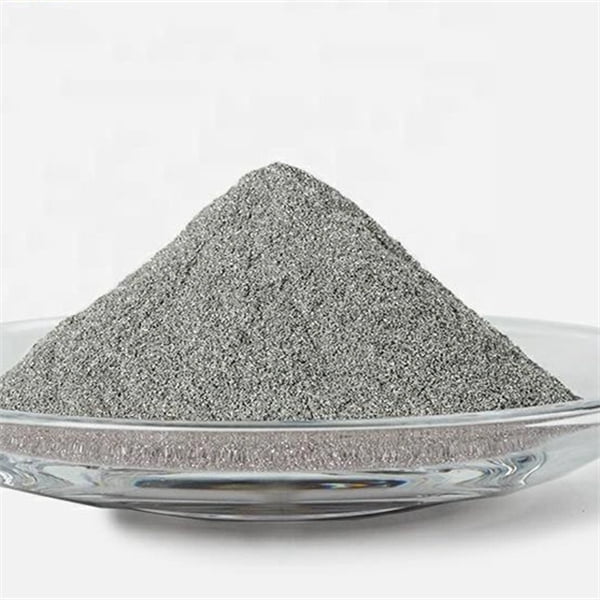
Vanliga frågor
| Fråga | Svar |
|---|---|
| Vad är volframpulver med hög densitet? | Volframpulver med densitet från 18 till 19,3 g/cm 3 – högst bland alla metallpulver |
| Hur tillverkas volframpulver med hög densitet? | Reduktion av renad volframoxid kombinerat med specialiserad fräsning för önskade partikelstorlekar |
| Vad används volframpulver med hög densitet till? | Tillverkning av motvikter, strålskärmning, ballast, viktblandningar, vibrationsdämpande komponenter m.m. |
| Vilka är de olika varianterna av högdensitetspulver? | Ren volfram, dopad volfram med sällsynta jordartsmetaller, volfram-nickel-järnlegeringar, tungsten tungstenslegeringar etc. |
| Vilka är fördelarna med volframpulver med hög densitet? | Extrem densitet i kompakta volymer oöverträffad av andra pulver; nätformad tillverkning till komplexa delar |
| Vilka är begränsningarna för volframpulver när du använder dem? | Relativt lägre hårdhet än volframkarbid; begränsad seghet och duktilitet innebär bearbetningsutmaningar |
| Hur jämförs högdensitetsvolframpulver med traditionella täta material som bly? | Säkrare än giftigt bly; högre smältpunkt än bly; ekonomiskt prissatt mot ädelmetaller med liknande densitet |
Sammanfattning
Med extraordinär densitet bland elementära metaller, erbjuder högrent volframpulver designers unika möjligheter för viktkänsliga applikationer som behöver kompakta profiler som inte är möjliga tidigare. Framsteg inom pulvertillverkning, pressning, sintring och sekundär bearbetning övervinner sprödhetsbegränsningar och låser upp en bredare användning. Blandning och legering ger ytterligare anpassning av fysikaliska egenskaper över krävande el-, kärnkrafts-, fordons- och rymdområden där hög densitet kopplas kritiskt till styrka, hårdhet och termisk härstamning.
Eftersom hållbara källor stödjer tillförlitliga globala försörjningskedjor, utnyttjar nu designers densitetsextremiteter i volframpulver för precisionsteknisk funktionalitet över branscher där tyngd och kompakthet tillsammans driver värde. Ledande tillverkare kommer att sträva efter att korsa densitetströsklar över 20 g/cm3 under det kommande decenniet eftersom volfram får större strategisk betydelse.
Dela på
MET3DP Technology Co, LTD är en ledande leverantör av lösningar för additiv tillverkning med huvudkontor i Qingdao, Kina. Vårt företag är specialiserat på 3D-utskriftsutrustning och högpresterande metallpulver för industriella tillämpningar.
Förfrågan för att få bästa pris och anpassad lösning för ditt företag!
Relaterade artiklar

Högpresterande segment för munstycksvingar: Revolutionerande turbineffektivitet med 3D-utskrift i metall
Läs mer "Om Met3DP
Senaste uppdateringen
Vår produkt
KONTAKTA OSS
Har du några frågor? Skicka oss meddelande nu! Vi kommer att betjäna din begäran med ett helt team efter att ha fått ditt meddelande.

Metallpulver för 3D-printing och additiv tillverkning
FÖRETAG
PRODUKT
cONTACT INFO
- Qingdao City, Shandong, Kina
- [email protected]
- [email protected]
- +86 19116340731






